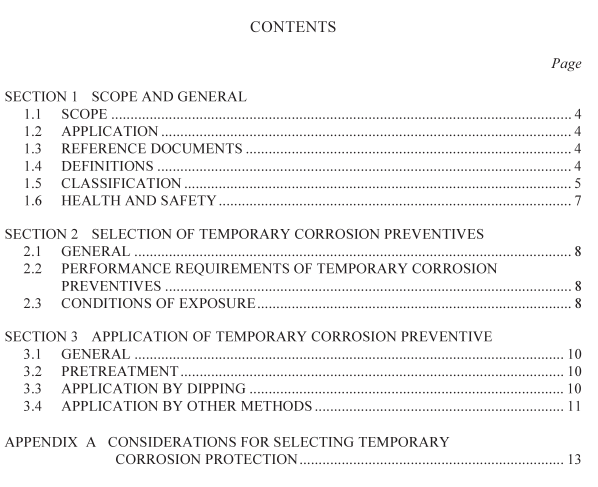AS 2400.5 pdf download – Packaging Part 5: Temporary corrosion protection

AS 2400.5 pdf download – Packaging Part 5: Temporary corrosion protection
3.1 GENERAL All temporary corrosion preventives may be supplied ready for use. Temporary corrosion protection is most commonly applied by dipping though other methods such as spraying, brushing, smearing, roller coating, flow or flood coating, flushing, circulation coating, barrelling and the use of volatile corrosion inhibitors (VCI) are used. These processes are discussed in Clauses 3.3 and 3.4.
NOTE: Appropriate regulations on the precautions necessary for work with these materials should be followed (see Clause 1.6). To achieve effective coating and optimum temporary corrosion protection the following procedures shall be followed:
(a) Surfaces (see Clause 3.2) shall be clean and moisture free and inspected prior to application. Once selected any article shall be cleaned, dried, inspected and coated in one complete, uninterrupted operation (to reduce the possibility of contamination) when applying a temporary corrosion preventive.
(b) Coating of appropriate surfaces shall be uniform and continuous. Application by dipping is preferable whenever size, shape and composition of the parts and nature of the preventive permits. NOTE: See Appendix A.
(c) Solvent-containing materials and oils shall be drained after dipping or spraying.
(d) Coated parts shall not be handled once the temporary corrosion preventive has been applied until the coating process has been completed, to prevent the temporary coating from being damaged.
3.2 PRETREATMENT There is no single, universal method of cleaning by which all surfaces can be prepared for the application of protective coatings (see AS 1627.0 and AS 1627.1).
3.3 APPLICATION BY DIPPING
3.3.1 Application The parts or assemblies to be coated shall be submerged in a bath of the temporary corrosion protective. They shall be turned as necessary in the bath to allow trapped air to escape. When not in use, the bath shall be covered to keep out dust and dirt. When solvent is present the cover restricts evaporation. For the same reason the top opening of the tank shall not be any larger than necessary. Solutions giving the thin, soft-film protectives sometimes allow some of the ingredients to settle out slowly on standing, and the bath should, therefore, be stirred occasionally with utmost care to keep it homogeneous. Otherwise it is better not to agitate the bath of preventive, as dirt and fibrous contaminants which can be serious drawbacks if they get into protective films, can settle to the bottom of the bath, and have to be cleaned out from time to time.
3.3.2 Baths of solvent-containing materials Baths of solvent-containing materials shall be kept at room temperature except where otherwise specified. Articles need only be immersed sufficiently to ensure complete wetting except with dewatering grades where adequate time for water displacement. The proportion of solvents and preventives shall be checked from time to time if the rate of use is low or if a very volatile solvent is present. 3.4 APPLICATION BY OTHER METHODS 3.4.1 Spraying Only the thin, solvent-containing fluids and the oils are normally sprayed. They shall be applied as received, not thinned down. It is more difficult to achieve an overall coating by spraying than by dipping. To ensure that an adequate amount of coating is applied, the surface may be completely wetted so the liquid coat can begin to flow. Aerosol containers are available from which protective material under pressure may be applied by a finger- press jet nozzle. NOTE: They are useful when limited application is required. 3.4.2 Brushing The brush shall be clean and, for solid preventive, carefully chosen to suit the consistency. The bristles shall be stiff enough to ensure intimate contact of the preventive with the surface, but not so stiff as to leave deep brush marks. It is often an advantage to apply a thin layer thoroughly and then build up to the requisite thickness later. Deep brush marks may lead to low film deposits.









